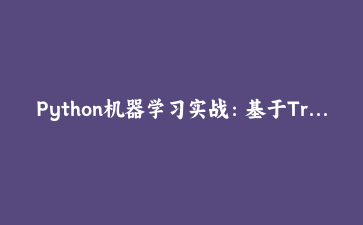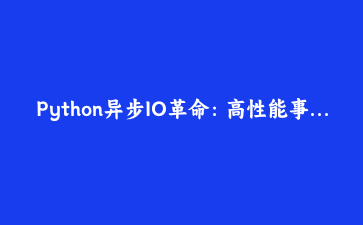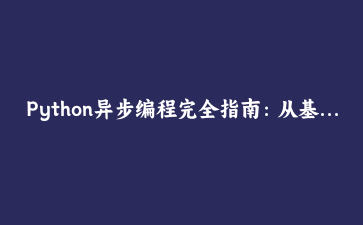引言:异步编程的时代意义
在现代Web开发和高性能应用中,异步编程已成为提升系统吞吐量的关键技术。Python通过asyncio模块提供了强大的异步IO支持,让开发者能够以同步的编码风格实现异步的高性能应用。本文将深入探讨asyncio的核心机制,并通过完整的电商库存管理系统案例展示实际应用。
一、异步编程基础概念
理解异步编程需要掌握几个核心概念,这些是构建高效异步应用的基础。
1.1 事件循环(Event Loop)机制
import asyncio
# 获取事件循环
loop = asyncio.get_event_loop()
# 创建简单协程
async def simple_coroutine():
print("开始执行协程")
await asyncio.sleep(1)
print("协程执行完成")
# 运行协程
loop.run_until_complete(simple_coroutine())1.2 async/await关键字深度解析
async def data_processor():
"""模拟数据处理协程"""
print("开始处理数据")
# await 挂起当前协程,等待IO操作完成
result = await fetch_from_database()
# 只有在上面的await完成后才会执行
processed_data = await process_data(result)
return processed_data
async def fetch_from_database():
await asyncio.sleep(0.5) # 模拟数据库查询
return {"id": 1, "name": "商品数据"}
async def process_data(data):
await asyncio.sleep(0.3) # 模拟数据处理
return f"处理后的数据: {data}"二、实战案例:异步电商库存管理系统
我们将构建一个完整的电商库存管理系统,展示异步编程在实际业务场景中的应用。
2.1 系统架构设计
import asyncio
import aiohttp
import json
from datetime import datetime
from typing import List, Dict
class InventoryItem:
"""库存商品类"""
def __init__(self, item_id: str, name: str, stock: int, price: float):
self.item_id = item_id
self.name = name
self.stock = stock
self.price = price
def to_dict(self):
return {
"item_id": self.item_id,
"name": self.name,
"stock": self.stock,
"price": self.price
}
class AsyncInventoryManager:
"""异步库存管理器"""
def __init__(self):
self.inventory: Dict[str, InventoryItem] = {}
self.initialize_sample_data()
def initialize_sample_data(self):
"""初始化示例数据"""
sample_items = [
InventoryItem("P001", "笔记本电脑", 50, 5999.0),
InventoryItem("P002", "无线鼠标", 200, 89.0),
InventoryItem("P003", "机械键盘", 150, 399.0),
InventoryItem("P004", "显示器", 80, 1299.0),
InventoryItem("P005", "USB-C扩展坞", 120, 199.0)
]
for item in sample_items:
self.inventory[item.item_id] = item2.2 并发库存查询系统
async def batch_check_stock(self, item_ids: List[str]) -> Dict[str, Dict]:
"""批量并发检查库存"""
async def check_single_item(item_id: str):
await asyncio.sleep(0.1) # 模拟网络延迟
item = self.inventory.get(item_id)
if item:
return {
"item_id": item_id,
"available": item.stock > 0,
"stock": item.stock,
"name": item.name
}
return {"item_id": item_id, "error": "商品不存在"}
# 并发执行所有检查任务
tasks = [check_single_item(item_id) for item_id in item_ids]
results = await asyncio.gather(*tasks, return_exceptions=True)
return {result["item_id"]: result for result in results
if not isinstance(result, Exception)}
async def concurrent_inventory_update(self, updates: Dict[str, int]):
"""并发库存更新"""
async def update_single_item(item_id: str, quantity: int):
await asyncio.sleep(0.05) # 模拟数据库更新延迟
if item_id in self.inventory:
self.inventory[item_id].stock += quantity
return {"item_id": item_id, "success": True, "new_stock": self.inventory[item_id].stock}
return {"item_id": item_id, "success": False, "error": "商品不存在"}
tasks = [update_single_item(item_id, quantity)
for item_id, quantity in updates.items()]
return await asyncio.gather(*tasks)三、高级异步模式应用
掌握高级异步模式可以进一步提升应用性能和代码质量。
3.1 异步上下文管理器
class AsyncDatabaseConnection:
"""异步数据库连接模拟"""
async def __aenter__(self):
print("建立数据库连接...")
await asyncio.sleep(0.2)
self.connected = True
return self
async def __aexit__(self, exc_type, exc_val, exc_tb):
print("关闭数据库连接...")
await asyncio.sleep(0.1)
self.connected = False
async def execute_query(self, query: str):
if self.connected:
await asyncio.sleep(0.3) # 模拟查询执行
return f"查询结果: {query}"
raise ConnectionError("数据库未连接")
async def use_async_context():
async with AsyncDatabaseConnection() as db:
result = await db.execute_query("SELECT * FROM inventory")
print(result)3.2 异步迭代器与生成器
class AsyncInventoryStream:
"""异步库存数据流"""
def __init__(self, inventory_manager: AsyncInventoryManager):
self.inventory_manager = inventory_manager
self.current_index = 0
self.item_ids = list(inventory_manager.inventory.keys())
def __aiter__(self):
return self
async def __anext__(self):
if self.current_index >= len(self.item_ids):
raise StopAsyncIteration
item_id = self.item_ids[self.current_index]
self.current_index += 1
# 模拟异步数据获取
await asyncio.sleep(0.05)
item = self.inventory_manager.inventory[item_id]
return item.to_dict()
async def process_inventory_stream():
"""处理异步库存数据流"""
manager = AsyncInventoryManager()
stream = AsyncInventoryStream(manager)
async for item_data in stream:
print(f"处理商品: {item_data['name']}, 库存: {item_data['stock']}")四、性能优化与错误处理
4.1 连接池与限流控制
import asyncio
from asyncio import Semaphore
class RateLimitedAPIClient:
"""带限流的API客户端"""
def __init__(self, max_concurrent: int = 5):
self.semaphore = Semaphore(max_concurrent)
async def make_request(self, url: str):
async with self.semaphore:
# 模拟API请求
await asyncio.sleep(0.2)
return f"响应来自: {url}"
async def concurrent_api_calls():
client = RateLimitedAPIClient(max_concurrent=3)
urls = [f"https://api.example.com/items/{i}" for i in range(10)]
tasks = [client.make_request(url) for url in urls]
responses = await asyncio.gather(*tasks)
for response in responses:
print(response)4.2 健壮的异常处理机制
async def robust_inventory_operation():
"""健壮的库存操作"""
manager = AsyncInventoryManager()
try:
# 并发执行多个操作
stock_check = manager.batch_check_stock(["P001", "P002", "P999"])
inventory_update = manager.concurrent_inventory_update({"P001": -2, "P002": 10})
# 使用wait_for设置超时
stock_result, update_result = await asyncio.gather(
asyncio.wait_for(stock_check, timeout=5.0),
asyncio.wait_for(inventory_update, timeout=3.0),
return_exceptions=True
)
# 处理结果
if isinstance(stock_result, Exception):
print(f"库存检查失败: {stock_result}")
else:
print("库存检查完成:", stock_result)
if isinstance(update_result, Exception):
print(f"库存更新失败: {update_result}")
else:
print("库存更新完成:", update_result)
except asyncio.TimeoutError:
print("操作超时,请重试")
except Exception as e:
print(f"系统错误: {e}")五、实际部署与监控
5.1 性能监控装饰器
import time
from functools import wraps
def async_timing_decorator(func):
"""异步函数执行时间监控"""
@wraps(func)
async def wrapper(*args, **kwargs):
start_time = time.time()
try:
result = await func(*args, **kwargs)
execution_time = time.time() - start_time
print(f"{func.__name__} 执行时间: {execution_time:.4f}秒")
return result
except Exception as e:
execution_time = time.time() - start_time
print(f"{func.__name__} 执行失败,耗时: {execution_time:.4f}秒,错误: {e}")
raise
return wrapper
@async_timing_decorator
async def monitored_inventory_check():
"""被监控的库存检查函数"""
manager = AsyncInventoryManager()
return await manager.batch_check_stock(["P001", "P002", "P003"])5.2 生产环境最佳实践
- 配置优化:根据服务器CPU核心数调整并发限制
- 内存管理:避免在协程中存储大量数据
- 日志记录:使用结构化日志记录异步操作
- 健康检查:实现异步健康检查端点
完整示例:运行异步库存系统
async def main():
"""主运行函数"""
print("=== 异步电商库存管理系统启动 ===")
manager = AsyncInventoryManager()
# 1. 批量检查库存
print("n1. 批量库存检查:")
stock_info = await manager.batch_check_stock(["P001", "P002", "P003", "P999"])
for item_id, info in stock_info.items():
if "error" in info:
print(f" {item_id}: {info['error']}")
else:
print(f" {info['name']}: {info['stock']}件")
# 2. 并发更新库存
print("n2. 并发库存更新:")
update_results = await manager.concurrent_inventory_update({
"P001": -5, # 销售出库
"P002": 50, # 采购入库
"P003": -2 # 销售出库
})
for result in update_results:
if result["success"]:
print(f" {result['item_id']} 更新成功,新库存: {result['new_stock']}")
else:
print(f" {result['item_id']} 更新失败: {result['error']}")
# 3. 使用异步上下文管理器
print("n3. 数据库操作演示:")
await use_async_context()
# 4. 处理异步数据流
print("n4. 库存数据流处理:")
await process_inventory_stream()
print("n=== 系统运行完成 ===")
if __name__ == "__main__":
# 运行主程序
asyncio.run(main())结语
Python的异步编程为处理I/O密集型任务提供了强大的解决方案。通过asyncio框架,我们能够以清晰的代码结构实现高并发应用。本文展示的电商库存管理系统案例涵盖了异步编程的核心概念和高级特性,包括协程管理、并发控制、错误处理和性能优化。在实际项目中,建议根据具体业务需求合理设计异步架构,平衡代码复杂性和性能收益,充分发挥异步编程的优势。
记住:异步不是万能的银弹,在CPU密集型任务中可能不会带来性能提升,甚至可能因为上下文切换而降低性能。正确识别应用场景,合理使用异步编程,才能构建出真正高效可靠的Python应用。













